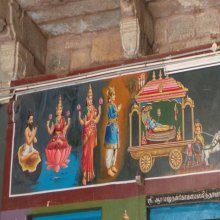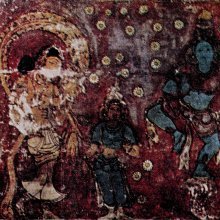Sthala, Sthalā, Sthāla: 22 definitions
Introduction:
Sthala means something in Buddhism, Pali, Hinduism, Sanskrit, the history of ancient India, Marathi, Hindi, biology. If you want to know the exact meaning, history, etymology or English translation of this term then check out the descriptions on this page. Add your comment or reference to a book if you want to contribute to this summary article.
Images (photo gallery)
(+8 more images available)
In Hinduism
Dharmashastra (religious law)
Source: Wisdom Library: Dharma-śāstraSthala (स्थल) refers to “artificially elevated ground”. This is used to mark the boundary between two villages. The word is used throughout Dharmaśāstra literature such as the Manusmṛti. (See the Manubhāṣya, verse 8.247)

Dharmashastra (धर्मशास्त्र, dharmaśāstra) contains the instructions (shastra) regarding religious conduct of livelihood (dharma), ceremonies, jurisprudence (study of law) and more. It is categorized as smriti, an important and authoritative selection of books dealing with the Hindu lifestyle.
Ayurveda (science of life)
Dietetics and Culinary Art (such as household cooking)
Source: Shodhganga: Dietetics and culinary art in ancient and medieval IndiaSthala (स्थल) or Sthalajāta refers to “rice grown in wild soil” and is classified as a type of grain (dhānya) in the section on śūkadhānya (awned grains) in the Bhojanakutūhala (dravyaguṇāguṇa-kathana), and is commonly found in literature dealing with the topics of dietetics and culinary art, also known as Pākaśāstra or Pākakalā.—The author explains the characteristics and the properties of various food grains (dhānyas). [...] General properties of rice which are [viz., grown in wet land (sthala-jāta-śāli)] are discussed here. The properties of different grains based on their habitat, variety of water for irrigating them are also explained.

Āyurveda (आयुर्वेद, ayurveda) is a branch of Indian science dealing with medicine, herbalism, taxology, anatomy, surgery, alchemy and related topics. Traditional practice of Āyurveda in ancient India dates back to at least the first millenium BC. Literature is commonly written in Sanskrit using various poetic metres.
Vastushastra (architecture)
Source: OpenEdition books: Architectural terms contained in Ajitāgama and RauravāgamaSthala (स्थल) refers to “floor of a room §§ 3.12; 4.7, 26; 5.3.”.—(For paragraphs cf. Les enseignements architecturaux de l'Ajitāgama et du Rauravāgama by Bruno Dagens)

Vastushastra (वास्तुशास्त्र, vāstuśāstra) refers to the ancient Indian science (shastra) of architecture (vastu), dealing with topics such architecture, sculpture, town-building, fort building and various other constructions. Vastu also deals with the philosophy of the architectural relation with the cosmic universe.
Purana and Itihasa (epic history)
Source: archive.org: Shiva Purana - English TranslationSthala (स्थल) refers to “abode”, according to the Śivapurāṇa 2.3.19 (“Kāma’s destruction by Śiva”).—Accordingly, as Śiva said to the Gods: “O gods, I am delighted. I shall resuscitate Kāma within myself. He will be one of my Gaṇas and will sport about always. O gods, this story should not be narrated in the presence of any one. All of you return to your abodes [i.e., sva-sthala]. I shall destroy all miseries”.

The Purana (पुराण, purāṇas) refers to Sanskrit literature preserving ancient India’s vast cultural history, including historical legends, religious ceremonies, various arts and sciences. The eighteen mahapuranas total over 400,000 shlokas (metrical couplets) and date to at least several centuries BCE.
Shaivism (Shaiva philosophy)
Source: SOAS University of London: Protective Rites in the Netra Tantra1) Sthala (स्थल) refers to the “ground (below one’s hips)”, according to the Netratantra of Kṣemarāja: a Śaiva text from the 9th century in which Śiva (Bhairava) teaches Pārvatī topics such as metaphysics, cosmology, and soteriology.—Accordingly, [verse 11.1-24ab, while describing the appearance and worship of Tumburu]—“[...] [He worships] Deva as Tumburu in the middle of an eight petaled lotus, in the maṇḍala, [starting] in the East, O Devī. [...] He [has] a half-moon in his topknot, sits in the blue lotus Āsana. [Tumburu is] white like a drop of frosty jasmine, similar to mountain snow. [He wears] a serpent as a sacred thread and is adorned with snake ornaments. [Tumburu is] adorned with all jewels, a tiger skin on the ground [below his] hips (vyāghracarman-kaṭi-sthala), a garment of elephant skin, mounted on a very strong bull, and wears a rhino hide. [...]”.
2) Sthala (स्थल) refers to a “heap” (of ritual fire).—Accordingly, [verse 13.25cd-28, while describing the appearance and worship of Viśvakarman]—“Furthermore, [I shall describe] Viśvakarman, the Lord of the world. [...] [The Mantrin] must honor [him] by praising (stūyamāna) Devas, Siddhas, and Gandharvas. [The Mantrin can choose to] worship [him] in a heap of [ritual] fire, or in water, or at mountains (parvatāgra—sthale'nale jale caiva parvatāgre prapūjayet). In whatever place he thinks [of Viśvakarman], [the deity] grants the fruits of desire”.

Shaiva (शैव, śaiva) or Shaivism (śaivism) represents a tradition of Hinduism worshiping Shiva as the supreme being. Closely related to Shaktism, Shaiva literature includes a range of scriptures, including Tantras, while the root of this tradition may be traced back to the ancient Vedas.
In Buddhism
Mahayana (major branch of Buddhism)
Source: academia.edu: A Study and Translation of the GaganagañjaparipṛcchāSthāla (स्थाल) is the name of flower, according to the Gaganagañjaparipṛcchā: the eighth chapter of the Mahāsaṃnipāta (a collection of Mahāyāna Buddhist Sūtras).—Accordingly, “To wit, the moon flower, the great moon flower, the most beautiful moon flower, [...] the brightening-colored flower, the Sthāla flower (sthāla), he great Sthāla flower (mahāsthāla), the beautiful Sthāla flower, the undefiled flower, the impeccable flower, the pure-light flower, the golden-light flower, [...] [The flowers] were adorned with their own splendor, produced by immeasurable merits, and known by Bodhisattvas of the ten directions. The great three-thousand thousands of worlds were covered with those flowers, and all congregations of the Lord were filled with flowers (puṣpa) up to their knees [...]”.

Mahayana (महायान, mahāyāna) is a major branch of Buddhism focusing on the path of a Bodhisattva (spiritual aspirants/ enlightened beings). Extant literature is vast and primarely composed in the Sanskrit language. There are many sūtras of which some of the earliest are the various Prajñāpāramitā sūtras.
India history and geography
Source: archive.org: Personal and geographical names in the Gupta inscriptionsSthāla (स्थाल) refers to a name-ending for place-names according to Pāṇini VI.2.129. Pāṇini also cautions his readers that the etymological meaning of place-names should not be held authoritative since the name should vanish when the people leave the place who gave their name to it.
Source: Cologne Digital Sanskrit Dictionaries: Indian Epigraphical GlossarySthala.—(IE 8-4), shortened form of deva-sthala; sometimes suffixed to names of localities; also the subdivision of a district. (IE 8-4; EI 12, 18, 24; ASLV), a small territorial unit like a Parganā; a district or its subdivision. Cf. Kona-sthala (EI 32), also called a deśa, maṇḍala, rāṣṭra, sīma, etc. (CITD), a place, habitation; a holy place; a district. Cf. sa-jala-sthala (IE 8-5); the land [of a village]. Cf. Tamil sthala-kkāval (SITI), village watch. Note: sthala is defined in the “Indian epigraphical glossary” as it can be found on ancient inscriptions commonly written in Sanskrit, Prakrit or Dravidian languages.

The history of India traces the identification of countries, villages, towns and other regions of India, as well as mythology, zoology, royal dynasties, rulers, tribes, local festivities and traditions and regional languages. Ancient India enjoyed religious freedom and encourages the path of Dharma, a concept common to Buddhism, Hinduism, and Jainism.
Biology (plants and animals)
Source: Google Books: CRC World Dictionary (Regional names)Sthala in India is the name of a plant defined with Cleome viscosa in various botanical sources. This page contains potential references in Ayurveda, modern medicine, and other folk traditions or local practices It has the synonym Polanisia orthocarpa Webb (among others).
Example references for further research on medicinal uses or toxicity (see latin names for full list):
· Flora Brasiliensis (1865)
· Indian Journal of Medical Research (1978)
· Acta Bot. Indica (1975)
· Journal of Ethnopharmacology (2003)
· Suppl. Meth. (Moench) (1802)
· Phytotherapy Research (1991)
If you are looking for specific details regarding Sthala, for example health benefits, extract dosage, pregnancy safety, diet and recipes, chemical composition, side effects, have a look at these references.

This sections includes definitions from the five kingdoms of living things: Animals, Plants, Fungi, Protists and Monera. It will include both the official binomial nomenclature (scientific names usually in Latin) as well as regional spellings and variants.
Languages of India and abroad
Marathi-English dictionary
Source: DDSA: The Molesworth Marathi and English Dictionarysthala (स्थल).—n (S) A place, a spot. 2 Stead, room, lieu, place. 3 A portion of land consisting of several fields. 4 An office or a situation, a station, post, place. 5 S Dry and firm ground; land or terra firma, as opp. to sea.
--- OR ---
sthaḷa (स्थळ).—&c. This is only the Prakrit form of writing. sthala and its compounds.
Source: DDSA: The Aryabhusan school dictionary, Marathi-Englishsthala (स्थल).—n A place; a station. Stead. Land.
Marathi is an Indo-European language having over 70 million native speakers people in (predominantly) Maharashtra India. Marathi, like many other Indo-Aryan languages, evolved from early forms of Prakrit, which itself is a subset of Sanskrit, one of the most ancient languages of the world.
Sanskrit dictionary
Source: DDSA: The practical Sanskrit-English dictionarySthala (स्थल).—[sthal-ac]
1) Firm or dry ground, dry land, terra firma (opp. jala); भो दुरात्मन् (bho durātman) (samudra) दीयतां टिट्टिभाण्डा- नि नो चेत्स्थलतां त्वां नयामि (dīyatāṃ ṭiṭṭibhāṇḍā- ni no cetsthalatāṃ tvāṃ nayāmi) Pañcatantra (Bombay) 1; प्रतस्थे स्थलवर्त्मना (pratasthe sthalavartmanā) R.4.6; so स्थलकमलिनी (sthalakamalinī) or स्थलवर्त्मन् (sthalavartman) q. v.
2) Shore, strand, beach.
3) Ground, land, soil (in general).
4) Place, spot; उवाच वाग्मी दशनप्रभाभिः संवर्धितोरःस्थलतारहारः (uvāca vāgmī daśanaprabhābhiḥ saṃvardhitoraḥsthalatārahāraḥ) R.5.52.
5) Field, tract, district.
6) Station.
7) A piece of raised ground, mound; ततः स्थलमुपारुह्य पर्वतस्याविदूरतः । ख्यातः पञ्चवटीत्येव नित्यपुष्पितकाननः (tataḥ sthalamupāruhya parvatasyāvidūrataḥ | khyātaḥ pañcavaṭītyeva nityapuṣpitakānanaḥ) || Rām.3.13.22.
8) A topic, case, subject, the point under discussion; विवाद°, विचार° (vivāda°, vicāra°) &c.
9) A part (as of a book).
1) A tent.
Derivable forms: sthalam (स्थलम्).
--- OR ---
Sthalā (स्थला).—A spot of dry ground artificially raised and drained (opp. sthalī q. v. below).
--- OR ---
Sthāla (स्थाल).—[sthalati tiṣṭhatyannādyatra ādhāre ghañ]
1) A plate or dish.
2) A cooking-pot, any culinary vessel; स्थालानां चषकाणां च भृङ्गाराणां च भूरिशः (sthālānāṃ caṣakāṇāṃ ca bhṛṅgārāṇāṃ ca bhūriśaḥ) Śiva B.29.58.
3) The hollow of a tooth.
Derivable forms: sthālam (स्थालम्).
Source: Cologne Digital Sanskrit Dictionaries: Edgerton Buddhist Hybrid Sanskrit DictionarySthāla (स्थाल).—nt., a kind of flower: Mahāvyutpatti 6185. Tibetan trans-literates.
Source: Cologne Digital Sanskrit Dictionaries: Shabda-Sagara Sanskrit-English DictionarySthala (स्थल).—nf. (-laṃ-lī) 1. Place, site, soil, dry or firm ground. 2. A natural spot, forest-land. nf.
(-laṃ-lā) A spot of dry ground prepared by art or drained and raised, &c., (as opposed to sthalī,) which is naturally so.) n.
(-laṃ) 1. A tent, a house of cloth. 2. A mound, a hillock. 3. Point, case, topic, subject, (of a description or discussion.) 4. Part, (as of a book.) 5. Firm or dry ground. 6. Shore, strand, beach. 7. Place, spot, soil, (in general.) 8. Field, tract, district. 9. Station. E. ṣṭhal to be firm, aff. ac .
--- OR ---
Sthāla (स्थाल).—n.
(-laṃ) 1. A caldron. 2. A plate or dish. 3. Any culinary utensil. f. (-lī) 1. An earthen pot or boiler. 2. A particular vessel used in the preparation of Soma. 3. The trumpet flower, (Bignonia suave olens.) E. ṣṭhā to stand, Unadi aff. ālac; or sthala-ghañ .
Source: Cologne Digital Sanskrit Dictionaries: Benfey Sanskrit-English DictionarySthala (स्थल).—[sthal + a], or rather sthā + la, I. n., and f. lī. 1. Firm or dry ground, [Hitopadeśa] i. [distich] 89, M. M. (la). 2. Place, [Vikramorvaśī, (ed. Bollensen.)] [distich] 79 (li); [Pañcatantra] 161, 15 (la). Ii. n., and f. lā, A spot drained and raised. Iii. n. 1. A mound, a terrace, [Meghadūta, (ed. Gildemeister.)] 67. 2. A tent. 3. Point, topic.
--- OR ---
Sthāla (स्थाल).—[sthā + la], I. n. A plate, a dish, [Rājataraṅgiṇī] 5, 46. Ii. f. lī, A pot, [Pañcatantra] 262, 16.
Source: Cologne Digital Sanskrit Dictionaries: Cappeller Sanskrit-English DictionarySthala (स्थल).—[neuter] raised or dry ground, land ([opposed] water), earth, ground, place, spot; sthalī [feminine] mound, eminence (also sthalā), ground, spot.
--- OR ---
Sthāla (स्थाल).—[neuter] plate, dish, vessel, tooth-hole; [feminine] sthālī (earthen) pot, kettle.
Source: Cologne Digital Sanskrit Dictionaries: Monier-Williams Sanskrit-English Dictionary1) Sthala (स्थल):—[from sthal] m. a chapter, section (of a book), [Catalogue(s)]
2) [v.s. ...] Name of a son of Bala, [Bhāgavata-purāṇa]
3) [v.s. ...] (sthalā), a heap of artificially raised earth, mound, [Taittirīya-saṃhitā]
4) [from sthal] n. = sthalī above
5) [v.s. ...] dry land (opp. to damp low-land), firm earth (opp. to water), [Taittirīya-saṃhitā] etc. etc.
6) [v.s. ...] ground, soil, place, spot, [Manu-smṛti; Mahābhārata; Rāmāyaṇa] etc.
7) [v.s. ...] a flat surface, roof (of a palace), [Meghadūta]
8) [v.s. ...] situation, circumstance, case (tathāvidha-sthale, ‘in such a case’), [Sāhitya-darpaṇa; Sarvadarśana-saṃgraha]
9) [v.s. ...] a topic, subject, [Horace H. Wilson]
10) [v.s. ...] a text, [ib.]
11) Sthāla (स्थाल):—[from sthal] a n. ([from] sthala, of which it is also the Vṛddhi form in [compound]) any vessel or receptacle, plate, cup, bowl, dish, caldron, pot, [???]
12) [v.s. ...] any culinary utensil, [Rājataraṅgiṇī]
13) [v.s. ...] the hollow of a tooth, [Yājñavalkya]
14) [from sthā] b etc. See p. 1262, col. 1.
15) c etc. See p. 1262, col. 1.
Source: Cologne Digital Sanskrit Dictionaries: Yates Sanskrit-English Dictionary1) Sthala (स्थल):—sthalati 1. a. To stand, be firm.
2) [(laṃ-lī)] 1. n. 3. f. Place, site, soil, dry ground. n. and 1. f. A spot drained and raised. n. A tent; a mound; a topic.
3) Sthāla (स्थाल):—(laṃ) 1. n. A caldron. f. (ī) An earthen pot; trumpet flower.
Source: DDSA: Paia-sadda-mahannavo; a comprehensive Prakrit Hindi dictionary (S)Sthala (स्थल) in the Sanskrit language is related to the Prakrit words: Thala, Thāla.
[Sanskrit to German]
Sanskrit, also spelled संस्कृतम् (saṃskṛtam), is an ancient language of India commonly seen as the grandmother of the Indo-European language family (even English!). Closely allied with Prakrit and Pali, Sanskrit is more exhaustive in both grammar and terms and has the most extensive collection of literature in the world, greatly surpassing its sister-languages Greek and Latin.
Hindi dictionary
Source: DDSA: A practical Hindi-English dictionarySthala (स्थल) [Also spelled sthal]:—(nm) land; place; site, location, venue; field (as [yuddhasthala] battlefield); -[kamala/padya] a kind of plant and its flowers; ~[cara/cārī] terrestrial; living on land; ~[ḍamarūmadhya] neck of land, isthmus; ~[mārga] roadway; •[se] by road, by land; -[senā] land forces, army.
...
Kannada-English dictionary
Source: Alar: Kannada-English corpusSthala (ಸ್ಥಲ):—[noun] = ಸ್ಥಳ [sthala].
--- OR ---
Sthaḷa (ಸ್ಥಳ):—
1) [noun] a specific part of the earth’s surface.
2) [noun] the solid part of the earth’s surface not covered by water.
3) [noun] a country, region, etc.
4) [noun] a space, area or spot, set apart or used for a particular purpose; a place.
5) [noun] a raised ground; a mound.
6) [noun] a place of origin or where a person lives.
7) [noun] something dealt with in discussion, study; a subject.
8) [noun] a division of a book; a chapter.
9) [noun] a portable shelter raised with skins, canvas, plastic or the like, supported by one or more poles or a frame and often secured by ropes fastened to pegs in the ground; a tent.
10) [noun] any of the (eighteen) traditional descriptions that constitute an essential part of an epic.
11) [noun] (vīr.) any of the six important stages in the progress of a devotee’s attainment of perfect identity with the Supreme Being.
12) [noun] the Supreme Being.
13) [noun] a district constituted by one hundred villages or towns.
14) [noun] (arch.) a unit of measure of land.
15) [noun] (match.) a symbol for the number eighteen.
Kannada is a Dravidian language (as opposed to the Indo-European language family) mainly spoken in the southwestern region of India.
See also (Relevant definitions)
Starts with (+83): Stalakarnam, Stalakkaval, Stalam, Stalamanmiyam, Stalamkaval, Stalankaccelavu, Stalavari, Stalavruksham, Sthala-akramana, Sthala-gauda, Sthala-golardha, Sthala-karana, Sthala-karnam, Sthala-mahatmya, Sthala-patha-karana, Sthala-vritti, Sthala-yatayata, Sthalabhumi, Sthalacara, Sthalacara-prani.
Ends with (+137): Abhedyasthala, Achyutasthala, Acyutasthala, Adhahsthala, Adhassthala, Adhasthala, Adisthala, Adrikritasthala, Agnisthala, Aikyasthala, Akayasthala, Amgalimgasthala, Amgasthala, Ankasthala, Apavadasthala, Arkasthala, Arudhasthala, Arunacalasthala, Asthala, Aupasthala.
Full-text (+323): Sthalacara, Balasthala, Sthalaja, Vakshahsthala, Kushasthala, Mahasthala, Gandasthala, Thala, Sthalata, Madhyasthala, Marusthala, Sthalapadmini, Katasthala, Sthalamanjari, Sthalasiman, Sthalashringata, Acyutasthala, Sthalapatha, Sthalavigraha, Utsthala.
Relevant text
Search found 40 books and stories containing Sthala, Sthalā, Sthāla, Sthaḷa; (plurals include: Sthalas, Sthalās, Sthālas, Sthaḷas). You can also click to the full overview containing English textual excerpts. Below are direct links for the most relevant articles:
A History of Indian Philosophy Volume 5 (by Surendranath Dasgupta)
Part 2 - Anubhava-sūtra of Māyideva < [Chapter XXXV - Vīra-śaivism]
Part 1 - History and Literature of Vīra-śaivism < [Chapter XXXV - Vīra-śaivism]
Part 6 - Vātulāgama < [Chapter XXXIV - Literature of Southern Śaivism]
Kamashastra Discourse (Life in Ancient India) (by Nidheesh Kannan B.)
2. Works on Kāmaśāstra (l): Anaṅgaraṅga < [Chapter 2 - An Appraisal of Kāmaśāstra Works in Sanskrit]
Garga Samhita (English) (by Danavir Goswami)
Verse 3.9.31 < [Chapter 9 - The Birth of Śrī Girirāja]
Verses 2.20.13-16 < [Chapter 20 - The Rāsa-dance Pastime]
Verse 5.6.26 < [Chapter 6 - Seeing Śrī Mathurā]
Trishashti Shalaka Purusha Caritra (by Helen M. Johnson)
Part 22: Description of Meru < [Chapter III - The initiation and omniscience of Ajita]
Bhakti-rasamrta-sindhu (by Śrīla Rūpa Gosvāmī)
Verse 3.3.4 < [Part 3 - Fraternal Devotion (sakhya-rasa)]
Verse 4.1.21 < [Part 1 - Laughing Ecstasy (hāsya-rasa)]
Verse 4.8.76 < [Part 8 - Compatible & Incompatible Mellows (maitrī-vaira-sthiti)]





